1993 CADILLAC FLEETWOOD tire type
[x] Cancel search: tire typePage 198 of 386
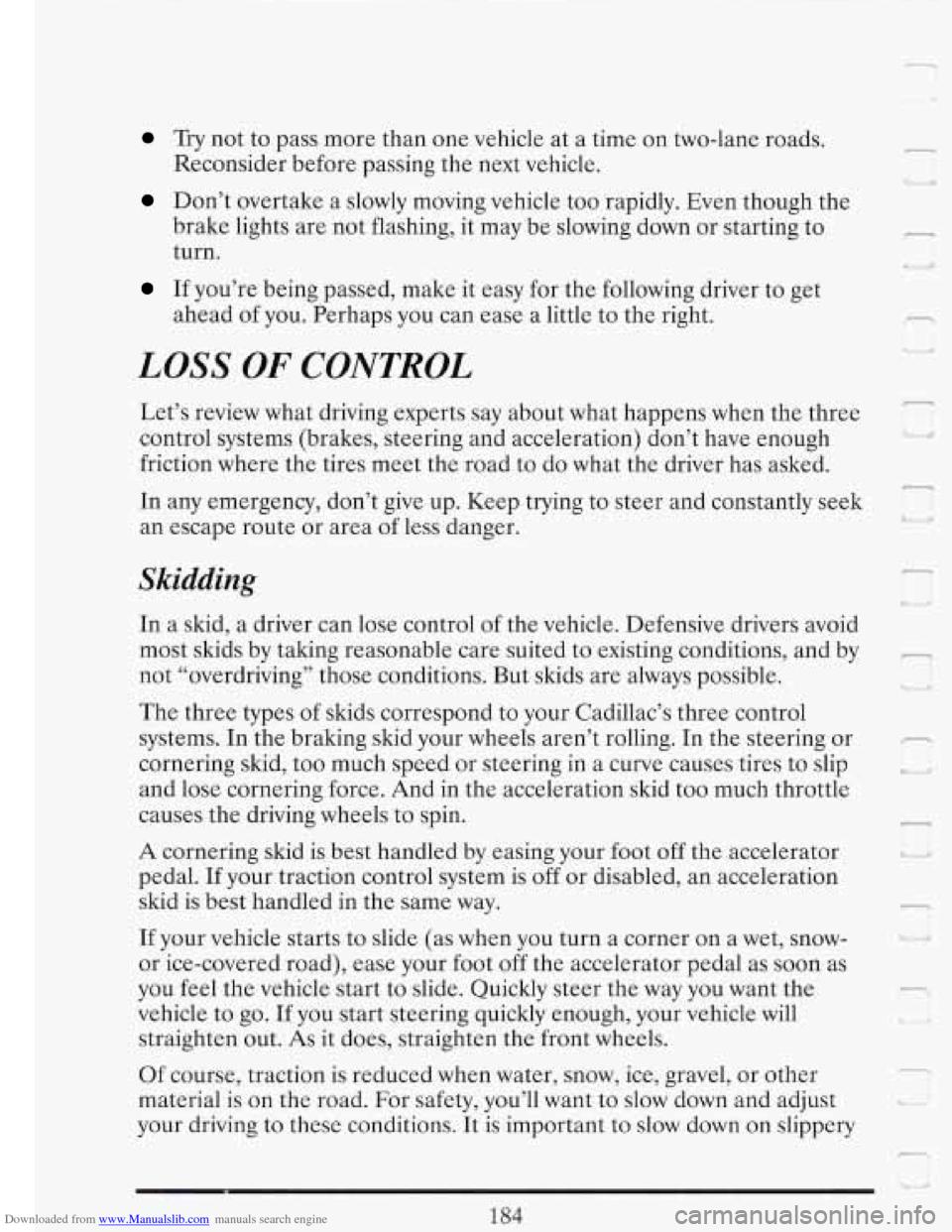
Downloaded from www.Manualslib.com manuals search engine Try not to pass more than one vehicle at a time on two-lane roads.
Reconsider before passing the next vehicle.
Don’t overtake a slowly moving vehicle too rapidly. Even though the
brake lights are
not flashing, it may be slowing down or starting to
turn.
If you’re being passed, make it easy for the following driver to get
ahead
of you. Perhaps you can ease a little to the right.
LOSS OF CONTROL
i
r
I/ U
Let’s review what driving experts say about what happens when the three
control systems (brakes, steering and acceleration) don’t have enough
’; I I
friction where the tires meet the road to do what the driver has asked.
r
In any emergency, don’t give up. Keep trying to steer and constantly seek
an escape route or area
of less danger.
-
le
Skidding
In a skid, a driver can lose control of the vehicle. Defensive drivers avoid
most skids by taking reasonable care suited to existing conditions, and by
._
not “overdriving” those conditions. But skids are always possible. < .,
The three types of skids correspond to your Cadillac’s three control
systems. In the braking skid your wheels aren’t rolling.
In the steering or
cornering skid, too much speed or steering in a curve causes tires to slip
and lose cornering force. And in the acceleration skid too much throttle
causes the driving wheels to spin.
A cornering skid is best handled by easing your foot off the accelerator
pedal.
If your traction control system is off or disabled, an acceleration
skid is best handled in the same way.
If your vehicle starts to slide (as when you turn a corner on a wet, snow-
or ice-covered road), ease your foot off the accelerator pedal as soon as
you feel the vehicle start to slide. Quickly steer the way you want the
vehicle to
go. If you start steering quickly enough, your vehicle will
straighten out.
As it does, straighten the front wheels.
Of course, traction is reduced when water, snow, ice, gravel, or other
material is on the road. For safety, you’ll want to slow down and adjust
your driving to these conditions. It is important to slow down on slippery
Lj
il t
1
-.
184
Page 237 of 386
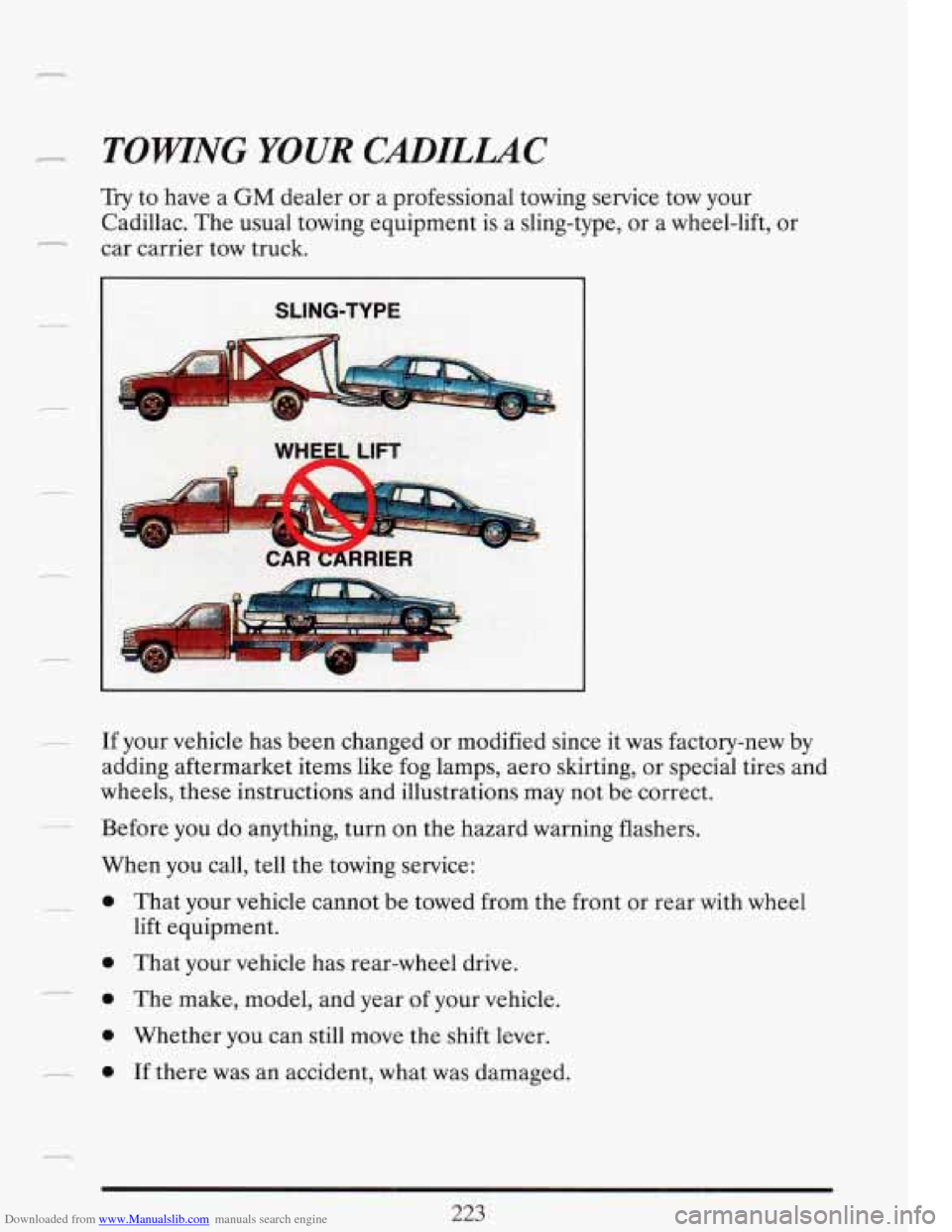
Downloaded from www.Manualslib.com manuals search engine TOWNG YOUR CXDILLAC
Try to have a GM dealer or a professional towing service tow your
Cadillac. The usual towing equipment
is a sling-type, or a wheel-lift, or
car carrier tow truck.
If your vehicle has been changed or modified since it was factory-new by
adding aftermarket items like fog lamps, aero skirting,
or special tires and
wheels, these instructions and illustrations may not be correct.
-- Before you do anything, turn on the hazard warning flashers.
When you call, tell the towing service:
0
0
0
-0
-
That your vehicle cannot be towed from the front or rear with wheel
lift equipment.
That your vehicle has rear-wheel drive.
The make, model, and year
of your vehicle.
Whether you can still move the shift lever.
If there was an accident, what was damaged.
223
Page 308 of 386

Downloaded from www.Manualslib.com manuals search engine ea
When to Check Check your tires once a month or more.
Don't forget your compact spare tire. It should be at
60 psi (420 kPa).
How to Check Use a good quality pocket-type gage to check tire
pressure. Simply looking at the tires
will not tell you the pressure,
especially
if you have radial tires -- which may look properly inflated even
if they're underinflated.
If your tires have valve caps, be sure to put them back on. They help
prevent leaks by keeping out dirt and moisture.
Your tire pressures are:
Front and rear - 30 psi (210 kPa)
Optional Limousine packages:
Front and rear - 35 psi (241 kPa)
Recommended tire size is:
0 P235/70R15 (Front and rear)
0 T145/80D 16 (Compact spare)
0 P235/75R15 XL (Coach Builder Option) d
n
'd I
294
Page 311 of 386
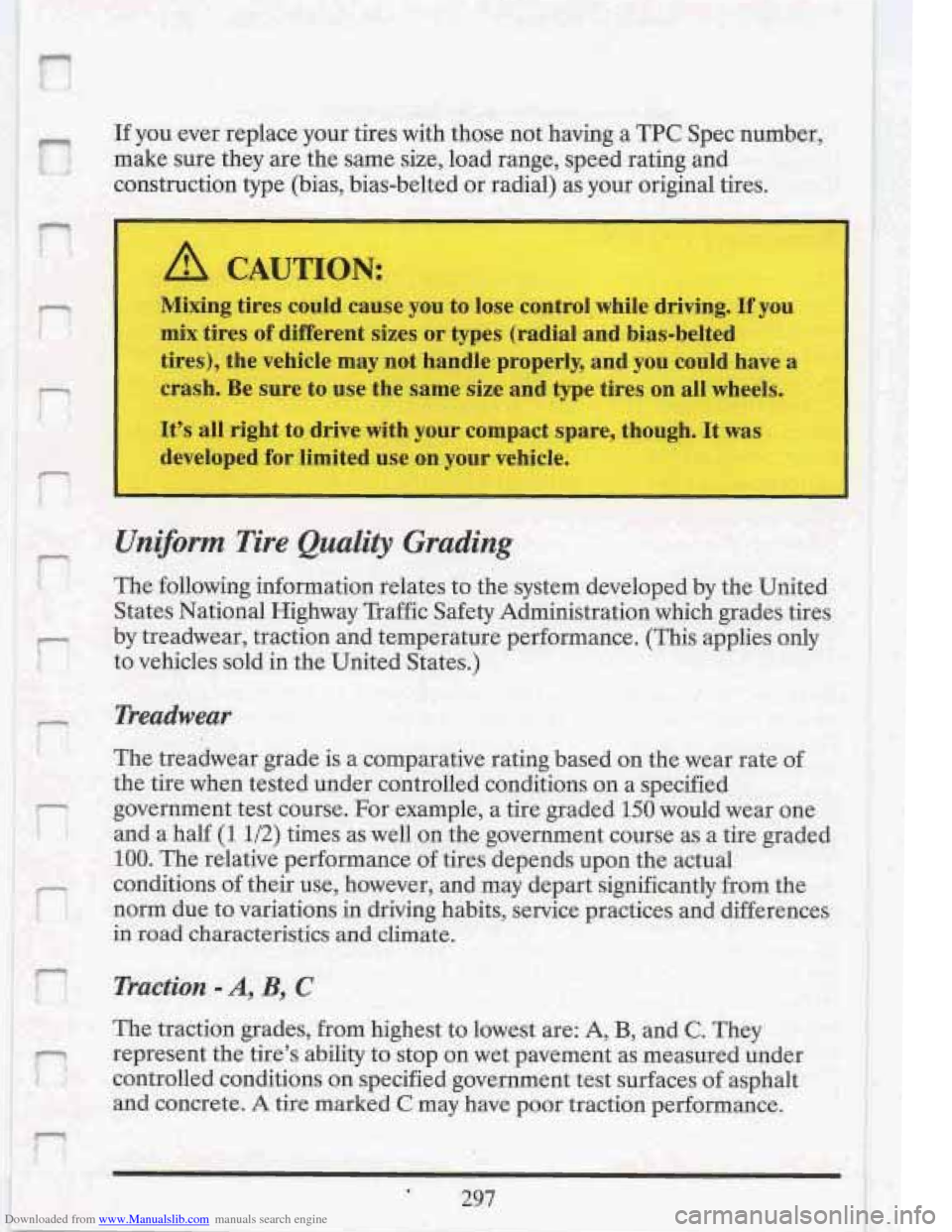
Downloaded from www.Manualslib.com manuals search engine i I
r I.
F 1.J
If you ever replace your tires with those not having a TPC Spec number,
make sure they are the same size, load range, speed rating and
construction type (bias, bias-belted or radial) as your original tires.
A CAUTION:
Mixing tires could cause you to lose control, while driving. If you
mix tires of different sizes or types (radial and bias-belted
tires), the vehicle may not handle properly, and you could have a
crash.
Be sure to use the same size and type tires on all wheels.
It's all right to drive with your compact spare, though. It was
developed for limited use
on your vehicle.
I
Ungorm Tire Quality Grading
The following information relates to the system developed by the United'
States National Highway Traffic Safety Administration which grades tires
I
by treadwear, traction and temperature performance. (This applies only
to vehicles sold in the United States.)
Treadwear
The treadwear grade is a comparative rating based on the wear rate of
the tire when tested under controlled conditions on a specified
government test course. For example, a tire graded
150 would wear one
and a half
(1 1/2) times as well on the government course as a tire graded
100. The relative performance of tires depends upon the actual
conditions
of their use, however, and may depart significantly from the
norm due to variations in driving habits, service practices and differences
in road characteristics and climate.
Traction -A, B, C !
-and concrete. A tire marked C may have poor traction performance. I I
The traction grades, from highest to lowest are: A, B, and C. They
represent the tire's ability to stop on wet pavement as measured under
controlled conditions on specified government test surfaces
of asphalt
Page 312 of 386
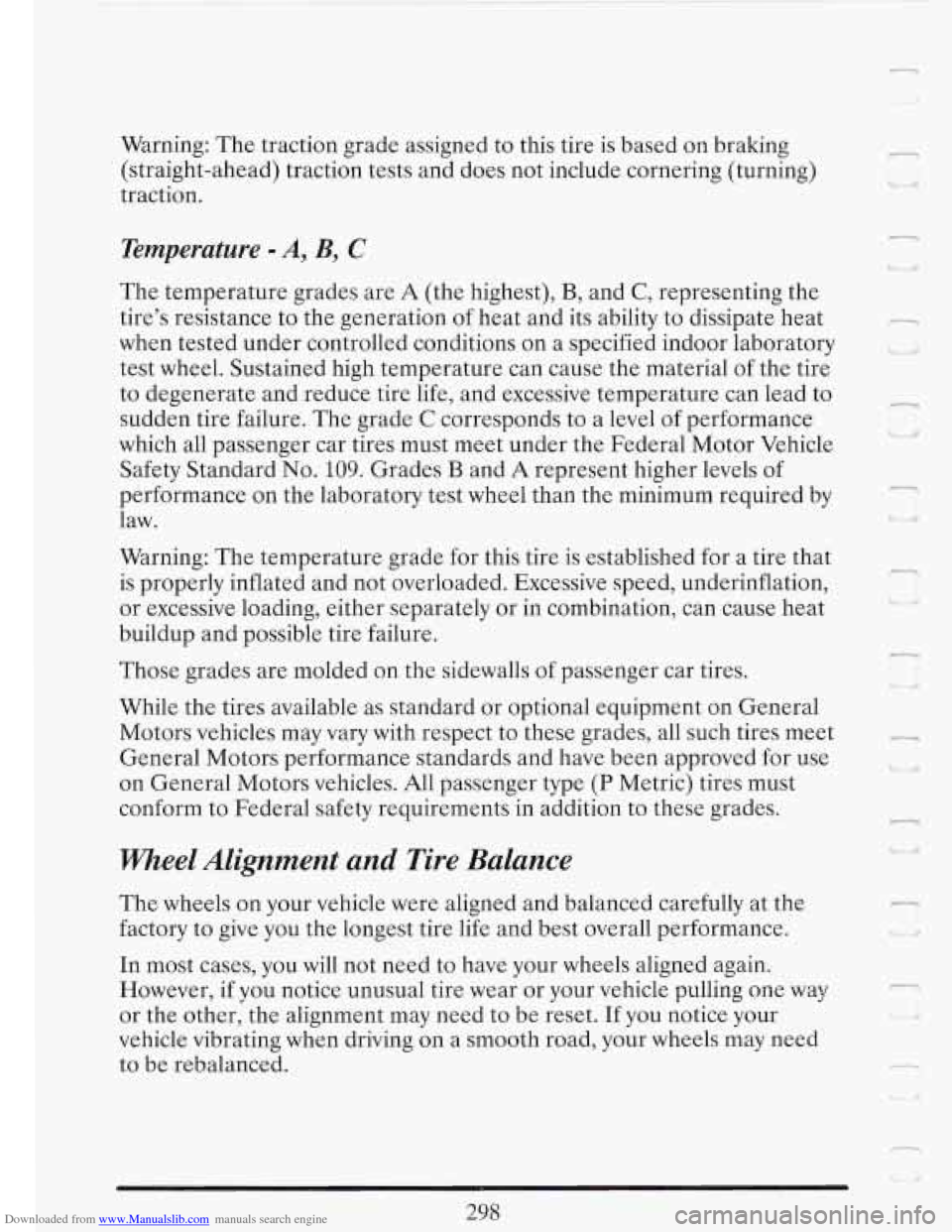
Downloaded from www.Manualslib.com manuals search engine 7
. .J
Warning: The traction grade assigned to this tire is based on braking
(straight-ahead) traction tests and does not include cornering (turning)
traction.
Temperature - A, B, C
The temperature grades are A (the highest), B, and C, representing the
tire's resistance to the generation of heat and its ability to dissipate heat
when tested under controlled conditions on a specified indoor laboratory
test wheel. Sustained high temperature can cause the material of the tire
to degenerate and reduce tire life, and excessive temperature can lead to
sudden tire failure. The grade
C corresponds to a level of performance
which all passenger car tires must meet under the Federal Motor Vehicle
Safety Standard
No. 109. Grades B and A represent higher levels of
performance on the laboratory test wheel than the minimum required by
law.
Warning: The temperature grade
for this tire is established for a tire that
is properly inflated and not overloaded. Excessive speed, underinflation,
or excessive loading, either separately or
in combination, can cause heat
buildup and possible tire failure.
Those grades are molded on the sidewalls of passenger car tires.
While the tires available as standard or optional equipment on General
Motors vehicles may vary with respect to these grades, all such tires meet
General Motors performance standards and have been approved for use
on General Motors vehicles.
All passenger type (P Metric) tires must
conform to Federal safety requirements in addition to these grades.
'Wheel Alignment and Tire Balance
The wheels on your vehicle were aligned and balanced carefully at the
factory to give you the longest tire life and best overall performance.
In most cases, you will not need
to have your wheels aligned again.
However,
if you notice unusual tire wear or your vehicle pulling one way
or the other, the alignment may need to be reset.
If you notice your
vehicle vibrating when driving
on a smooth road, your wheels may need
to be rebalanced.
3
I
c
UI
n
9
u
298
Page 317 of 386
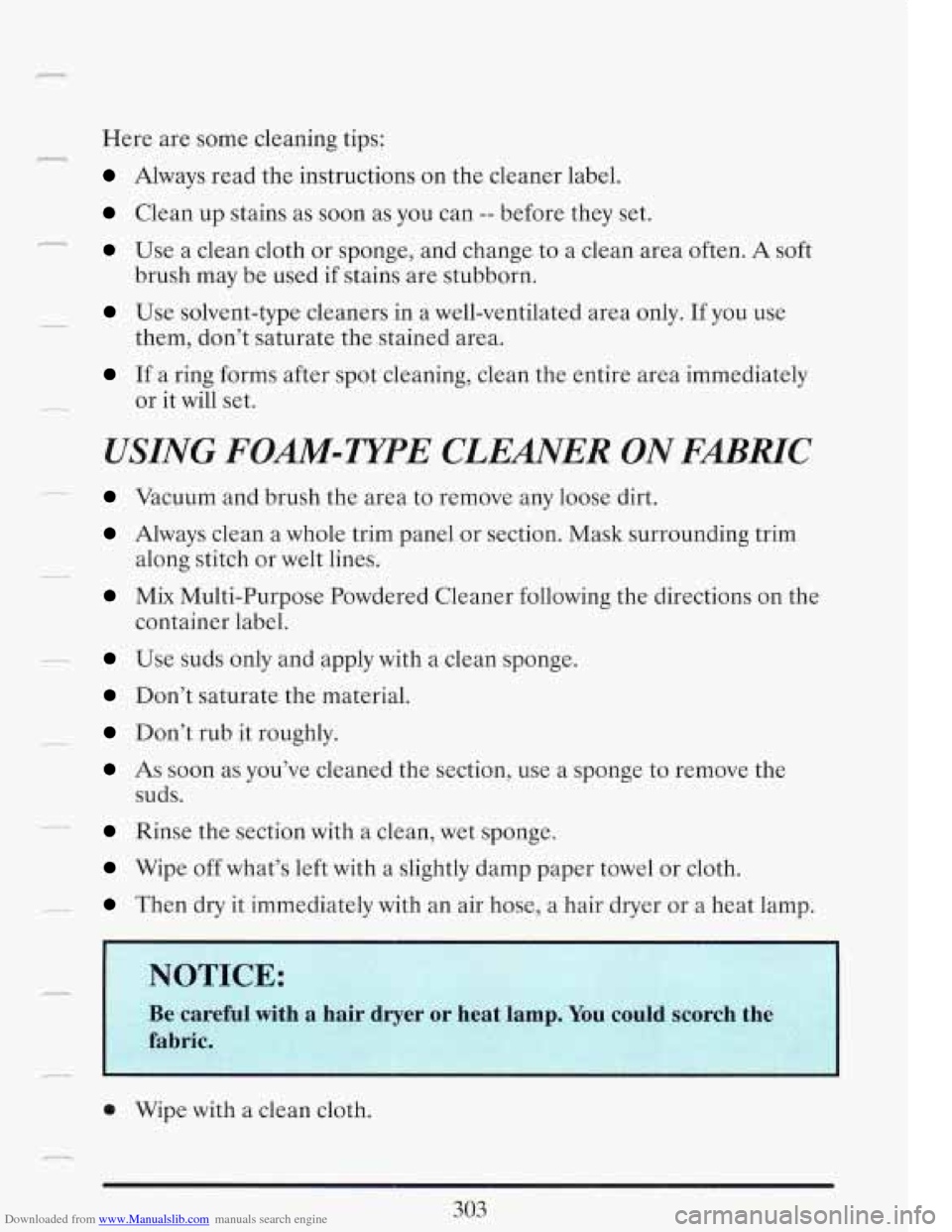
Downloaded from www.Manualslib.com manuals search engine r
r
Here are some cleaning tips:
Always read the instructions on the cleaner label.
Clean up stains as soon as you can -- before they set.
Use a clean cloth or sponge, and change to a clean area often. A soft
Use solvent-type cleaners in a well-ventilated area only. If you use
If a ring forms after spot cleaning, clean the entire area immediately
brush
may be used if stains are stubborn.
them, don't saturate the stained area.
or it will set.
USING FOA2M-T"E CLEANER ON FABRIC
Vacuum and brush the area to remove any loose dirt.
Always clean a whole trim panel or section. Mask surrounding trim
Mix Multi-Purpose Powdered Cleaner following the directions on the
Use suds only and apply with a clean sponge.
Don't saturate the material.
Don't rub it roughly.
As soon as you've cleaned the section, use a sponge to remove the
Rinse the section with a clean, wet sponge.
Wipe off what's left with a slightly damp paper towel or cloth.
Then dry it immediately with an air hose, a hair dryer or a heat lamp.
along
stitch or welt lines.
container label.
suds.
303
0 Wipe with a clean cloth.
Page 324 of 386
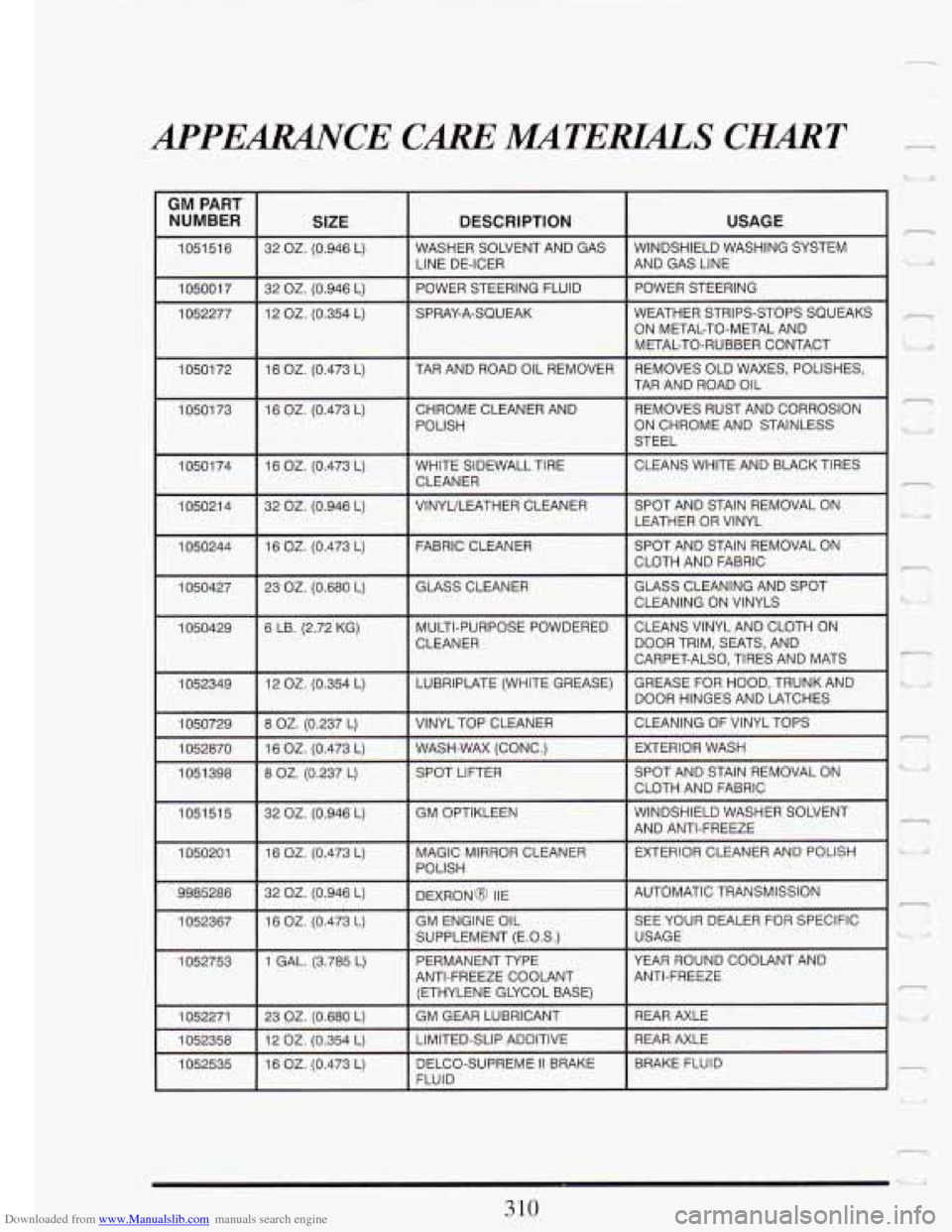
Downloaded from www.Manualslib.com manuals search engine APPEMCE CAREM!XTERUL,S CHMT
GM PART
NUMBER SIZE DESCRIPTION
1051516 32 OZ. (0.946 L) WASHER SOLVENT AND GAS
LINE DE-ICER
105001 7 32
OZ. (0.946 L) POWER STEERING FLUID
12
OZ. (0.354 L) SPRAY-A-SQUEAK
10501 72 16
OZ. (0.473 L) TAR AND ROAD OIL REMOVER
I 10501 73 I 16 OZ. (0.473 L) I CHROME CLEANER AND
I
1050174 16 OZ. (0.473 L) WHITE SIDEWALL TIRE
CLEANER
VINYL/LEATHER CLEANER
MULTI-PURPOSE POWDERED
CLEANER
1052870 16 OZ.
(0.473
L) WASH-WAX (CONC.)
8
OZ. (0.237 L) SPOT LIFTER
1051 51
5 32 OZ. (0.946 L) GM OPTIKLEEN
1050201 16
OZ. (0.473 L) MAGIC MIRROR CLEANER
POLISH
I 9985286 I 32 OZ. (0.946 L) I DEXRONB IIE
I 1052367
1052753
1052271 16
OZ. (0.473 L) GM
ENGINE OIL
SUPPLEMENT (E.O.S.)
1 GAL. (3.785 L) PERMANENT TYPE
ANTI-FREEZE COOLANT
(ETHYLENE GLYCOL BASE)
23
OZ. (0.680 L)
DELCO-SUPREME
II BRAKE
16 OZ. (0.473 L) LIMITED-SLIP ADDITIVE
12 OZ. (0.354 L) GM
GEAR LUBRICANT
FLUID
USAGE
WINDSHIELD WASHING SYSTEM
AND GAS LINE
POWER STEERING
WEATHER STRIPS-STOPS SQUEAKS
ON METAL-TO-METAL AND
METAL-TO-RUBBER CONTACT
REMOVES OLD WAXES, POLISHES,
TAR AND ROAD OIL
REMOVES RUST AND CORROSION
ON CHROME AND STAINLESS
STEEL
CLEANS WHITE AND BLACK TIRES
SPOT AND STAIN REMOVAL ON
LEATHER
OR VINYL
SPOT AND STAIN REMOVAL ON
CLOTH AND FABRIC
GLASS CLEANING AND SPOT
CLEANING ON VINYLS
CLEANS VINYL AND CLOTH ON
DOOR TRIM, SEATS, AND
CARPET-ALSO, TIRES AND MATS
GREASE FOR HOOD, TRUNK AND
DOOR HINGES AND LATCHES
CLEANING OF VINYL TOPS
EXTERIOR WASH
SPOT AND STAIN REMOVAL ON
CLOTH AND FABRIC
WINDSHIELD WASHER SOLVENT
AND ANTI-FREEZE
EXTERIOR CLEANER AND POLISH
AUTOMATIC TRANSMISSION SEE YOUR DEALER FOR SPECIFIC
USAGE
YEAR ROUND COOLANT AND
ANTI-FREEZE
REAR AXLE
REAR AXLE
BRAKE FLUID
.-
JI
7
'I-i I I
J ~
.-
310
Page 380 of 386

Downloaded from www.Manualslib.com manuals search engine Shift Lever, Positions Of. ............................. 83
Shifting Into Park ................................... 89
Shifting Out of Park ................................. 91
Signaling Turns ..................................... 98
Signs, Road ....................................... 157
Slippery Surfaces, Driving On ........................ 205
Snow, If You’re Stuck In Deep ........................ 208
Snow Or Ice, Driving On ............................ 204
Solvent-Type Cleaner On Fabric ...................... 304
Sound Equipment, Adding ........................ 143,312
Sound System ...................................... 142
Sound System, How to Operate Your .................. 145
Spare Tire ......................................... 248
Specifications ...................................... 321
Speedometer And Odometer ......................... 124
Stains, Removing ................................... 302
Start (Ignition Key Position) .......................... 79
Starting Your Engine ................................ 80
Starting Your Car If The Battery Is “Dead” ............. 218
Steam From Hot (Overheated) Engine ................. 227
Steep Hill, Parking On A ............................ 200
Steering .......................................... 179
Steering, Power ..................................... 95
Steering In Emergencies ............................. 180
Steering Tips ...................................... 179
Steering Without Power Assist ........................ 179
Stereo Sound Systems ............................... 142
Storing Your Vehicle ................................ 278
Stuck, If Your Ignition Key Is .......................... 80
Sunglasses, Wearing At Night ........................ 186
Supplemental Inflatable Restraint System ............... 27
Symbols Used On Your Vehicle ......................... 3
Skidding .......................................... 184
Smaller Children, Use Of Lap-Shoulder Belt ............. 44
Snowstorm, If You’re Caught In A Bad ................ 206
Steering Wheel, Tilt ................................. 95
StorageArmrest ................................... 122
Stuck, If Car Is . In Sand, Mud, Ice Or Snow ............ 249
Subscribing to Cadillac Product Sew. ... See Owner Assistance
T
Table Of Contents ....... See “Front of Owner Info. Manual”
Taillight Bulb Replacement
.......................... 282
Tamper-Resistance Of Odometer ..................... 124
Tape Player Care ................................... 155
Temperature, Engine, Warning Light .................. 128
P
-f
I
.I U
-
-1
n
14